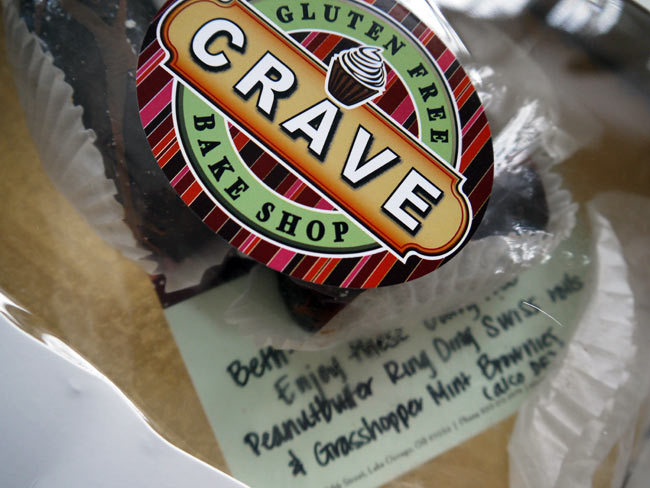Kyra's Baking Class: Replacing Common Ingredients
 Friday, May 18, 2012 at 5:41PM
Friday, May 18, 2012 at 5:41PM  Kyra Bussanich from Crave Bake Shop tagged
Kyra Bussanich from Crave Bake Shop tagged  Crave Bake Shop,
Crave Bake Shop,  Kyra Bussanich,
Kyra Bussanich,  baking tips,
baking tips,  dairy-free,
dairy-free,  egg-free,
egg-free,  flours,
flours,  gluten-free
gluten-free  Email Article
Email Article  Print Article in
Print Article in  Recipe,
Recipe,  Tips (Baking)
Tips (Baking) 
Welcome to New guest blogger, Kyra Bussanich! Kyra is the first gluten-free winner EVER of the Food Network's Cupcakes Wars and owner of Crave Bake Shop in Portland Oregon. Once a month will be helping us with tips and tricks to allergen-free baking -- how lucky are we! Plus, she will be sharing some of her wonderful recipes. Thank you for jumping on the blog, Kyra, and for becoming part of the Tender Foodie community.
~ Elisabeth Veltman
The Three Legs of Baking
There are three legs to fantastic baking: gluten, eggs, and sugar.
Each contributes something to the texture and structure of the final product, and when you have already replaced one of the legs of the stool, it makes it more difficult to successfully swap out the remaining two legs without adversely affecting flavor or texture (or both). This is why gluten-free and egg-free baking present such a challenge.
So in this first post, I'm going to offer an overview of replacements for some of the common allergens in baking, offer my opinions on them, and help you understand how they react together. This kind of understanding is a first step in making some baking magic in the kitchen.
Egg Replacements
I personally am not a fan of egg-replacers in bread, or most baked goods that need structure. Sandwich bread, for instance, needs a lot of structure. That said, you can swap out things like ground flaxmeal for the eggs, but it WILL affect the flavor and the texture. That's not to say it can't be delicious; but it WILL be different.
Yeast Replacements (for Rising)
To replace yeast, I use mechanical leavening in the form of baking powder or baking soda.
If you use baking soda, there should be some sort of acid to enact the baking soda (vinegar, apple cider viegar, lemon juice). The trick is to get the bread to rise without tasting too tangy from the baking soda and acid.
My Favorite Gluten-Free Flours
I adore millet flour, sorghum, teff, quinoa (which is spendy) and sweet white rice flour (mochiko)! I prefer teff flour over buckwheat for that dark, almost nutty taste and texture!
Difference in Gluten-Free Flours
When formulating our products at Crave, I really went back to basics and studied the protein content of the different "gluteny" flours and how that affected the texture of the baked goods.
For instance:
Pastry flour: has a relatively low protein content of around 9% which helps make very light, flaky crusts and cookies.
Bagels: are made with "high-gluten" flour which has a protein content of 14% to make the bagels dense and chewy.
These differences in protein may not seem like much, but when you think about the finished product (like pie crust versus bagels) you see that the protein content of the flours results in completely different textures. I'm simplifying a lot here, but the point I'm making is that instead of using a one-stop "all purpose" mix for everything, I tailor each recipe according to the texture I want the finished product to have, and I select various gluten-free flours and starches based on their protein content.
So, when I'm making bagels, I want them to have a higher protein content than our cakes, so I use sorghum and millet flour (and sometimes teff), instead of starchier components. I realize this doesn't adequately answer this question, so let me retrace my steps...
The Protein Differences in Gluten-free Flours
Because gluten-free flours tend overall to be very refined and starchier than wheat flours, and because they are missing that vital protein for structure and elasticity, it is imperative to add extra protein or binders into gluten-free bread recipes.
Sometimes I simply add additional egg whites; sometimes I use xanthan gum, and sometimes I use psyllium seeds. I've heard of other places also using gelatin for stretch, but I don't prefer to go that route.
Xanthan Gum -- How it works & What to Replace it With
Xanthan gum is a binder, acting much in the way of gluten in terms of holding everything together. And just like gluten, the more you work it, the stronger it acts (so don't overmix your dough)! With xanthan gum, as with gluten, baked goods will shrink up after they're baked if you've played with the dough too long or too vigorously.
Other binding agents: guar gum, ground psyllium seeds, gelatin, agar agar...the list goes on!
Dairy Replacements
Rice milk, or almond milk, if you can tolerate nuts. Coconut milk if you're making a sweeter bread or for dinner rolls. Or, you could just use eggs and no milk at all, if you can tolerate the eggs!
No "One Size Fits All" Replacement Method
I find that there is no all-purpose formula for replacements (I know you don't like this answer!). A lot of it depends on the ratio of flours to hydration, what you're using to hydrate, and then the other ingredients that are present in the recipe. I'm sorry I can't be more help, but sometimes I find that I might need 1 tablespoon of xanthan per cup of flour or starch and other times that's just way too much and 1/4 teaspoon will do. See what I mean?
Hopefully this answers some of your "why's" and "wherefore's" of how allergen-free baking is different. I'll see you next month with more tips. If you have any questions, post them here! Or give the Tender Foodie an E-Jingle. I'll do my best to include answers to them in upcoming posts whenever possible!
About Kyra
 Kyra Bussanich is the owner of Crave Bake Shop, and the first gluten-free winner of the Food Network's Famed, "Cupcakes Wars". Kyra graduated with honors from the prestigious Le Cordon Bleu patisserie program, which gave her a solid foundation of knowledge about classical French baking techniques which she was able to apply toward baking gluten-free. Kyra was diagnosed with an auto-immune disorder when she was 20 years old. Part of staying healthy meant switching to a gluten-free diet, avoiding all wheat and overly processed foods. Whenever possible, she uses local ingredients, and serves customers with multiple allergies, as well.
Kyra Bussanich is the owner of Crave Bake Shop, and the first gluten-free winner of the Food Network's Famed, "Cupcakes Wars". Kyra graduated with honors from the prestigious Le Cordon Bleu patisserie program, which gave her a solid foundation of knowledge about classical French baking techniques which she was able to apply toward baking gluten-free. Kyra was diagnosed with an auto-immune disorder when she was 20 years old. Part of staying healthy meant switching to a gluten-free diet, avoiding all wheat and overly processed foods. Whenever possible, she uses local ingredients, and serves customers with multiple allergies, as well.

